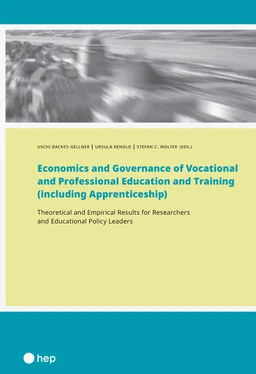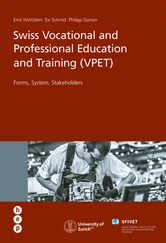The state and the various institutions involved in VPET have to carry out several functions within the VPET system: First, VPET needs to prepare individuals for (short and long-term) employment. This function requires close education-employment linkage ( Bolli et al., 2018). Second, VPET needs to be of good quality. For this function, the delivery of VPET needs both supervision and quality assurance. Third, the provision of sufficient training places requires processes that regularly review the market for training places. Fourth, as firms and individuals invest in VPET only if they expect a positive return, the institutional framework must include financing conditions and mechanisms that are sustainable and regularly reviewed. Fifth, for an entire VPET system to be sustainable, its efficiency, effectiveness, and equity have to be analyzed and backed up by research. Thus, institutions must monitor the system and generate evidence on and insights into fundamental and applied research questions.
Using several empirical studies, Chapter 5investigates these functions. For example, Bolli et al. (2018) show that the most important characteristics of high education-employment linkage are employer involvement in the definition of qualification standards, employer involvement in deciding the timing of curriculum updates, and the combination of workplace training with classroom education. In addition, Muehlemann et al. (2010)show that labor market regulations are not a necessary precondition for the existence of a VPET system. Instead, if companies involved in VET have great freedom in how they organize training and how they involve apprentices in productive work, a successful VPET system can exist in a deregulated labor market.
Recent research faces the challenge of measuring and comparing VPET systems across countries. Rageth and Renold (2019)develop a methodological-theoretical VET typology approach that bypasses the heterogeneous context conditions of specific VET programs. This VET typology makes possible comparing VET programs based on the criteria that affect labor market outcomes. In a similar vein, Renold et al. (2016)empirically assess the linkage intensity between actors from the education and employment systems of multiple countries, with results showing that both Switzerland and Germany are among the countries with the highest education-employment linkage.
One challenge for improving VPET systems is that, although research provides an outline of how successful systems work in various contexts, less evidence is available on implementing new systems or monitoring and evaluating system progress. Reviewing the literature on implementing VET programs, Caves and Baumann (2018)develop a five-category framework of success factors. Renold et al. (2019)apply that framework to the monitoring of an implementation process in Serbia, and Bolli et al. (2019)do the same in Nepal. Despite it being relatively new, this research area should yield a basis of evidence supporting the transition from nonexistent, very weak, or weak VPET systems to stronger and more successful systems.
Thus, a well-functioning VPET system represents an equilibrium comprising many components, all of which must be coordinated and shared among the actors and institutions involved. When one component changes, the equilibrium in the system can be upset, with undesirable consequences not only for the VET actors (i.e., training firms and those who want to become apprentices) but also throughout the education system. Therefore, systemic governance is important for simultaneously monitoring the different components and assessing the consequences of single policy decisions for the overall system. Such governance should strive to balance the interests of single actors and to support shared ownership.
Chapters 3through 5all have a similar structure: After a brief introduction, the original research papers are reprinted in their original layout by permission of the publisher, with each preceded by a non-technical summary. Afterwards, the sub-chapters “Ongoing Research” briefly summarize new research that is not yet published but can be found online as working papers.
In Chapter 6, “ Monitoring the Youth Labor Market Situation Around the Globe,” Ursula Renold and co-authors present the KOF Youth Labor Market Index (KOF YLMI). This index consists of 12 indicators that reflect the labor market situation for young people aged 15–24. These indicators include the extent to which the young people are active on the labor market, the working conditions of existing employment, the quantity and quality of education and training, and the smoothness of the transition from education into the labor market. Researchers and policy makers can use the index, which includes an interactive web tool for individually analyzing countries, to examine one youth cohort in one country, one cohort across countries, the evolution of the youth labor market across cohorts in one country, or multiple cohorts across countries. The chapter also shows some examples of how one can use the KOF YLMI to shed light on a specific aspect of the youth labor market. Among other things, the index presents the situations of the youth labor market before, during, and after the Great Recession of 2008. Thus, the KOF YLMI provides an internationally comparable outcome measurement for the youth labor market situation, making the index a useful analytical and diagnostic tool for discussing the (further) development of VET in many countries.
The last parts of the book contain supplementary material that helps clarify the terminology used in this book and compare different international VPET systems. The appendices also indicate further research for use for more in-depth results on a large number of questions raised in this book.
In Appendix A, “ Glossary,” we present all definitions used in this book for describing the educational systems in (mainly) Switzerland and Germany, and definitions used for reporting the results from the large number of studies in this book.
In Appendix B, “ Further Readings on PVET,” we present a list of further readings (publications and recent working papers) of both the Leading House on the Economics of Education and the KOF Comparative Education Systems Group.
We are grateful to our co-authors, from all the papers presented in this volume, for their cooperation and comments, and we are thankful in particular for their support in writing the policy briefs. Thanks also go to the Swiss State Secretariat for Education, Research and Innovation (SERI) for the generous financial support of the Leading House “Economics of Education” since 2006, support that gave us the opportunity to produce the portfolio of research presented in this book. We also thank all our co-authors for granting us the rights to reprint this large number of scholarly articles.
We hope that this overview of our current state of research on VPET makes a significant contribution to the development and improvement of VPET systems and provides valuable input for future research.
Acemoglu, D., & Pischke, J. S. (1998). Why do firms train? Theory and evidence. The Quarterly Journal of Economics, 113 (1), 79–119. doi:10.1162/003355398555531
Backes-Gellner, U. (1996). Betriebliche Bildungs- und Wettbewerbsstrategien im deutsch-britischen Vergleich: Ein Beitrag der Personaloekonomie zur internationalen Betriebswirtschaftslehre. Muenchen: Hampp.
Backes-Gellner, U., & Geel, R. (2014). A comparison of career success between graduates of vocational and academic tertiary education. Oxford Review of Education, 40 (2), 266–291. doi:10.1080/03054985.2014.889602
Backes-Gellner, U., & Tuor, S. N. (2010). Avoiding labor shortages by employer signaling: On the importance of good work climate and labor relations. Industrial and Labor Relations Review, 63 (2), 271–286. doi:10.1177/001979391006300205
Читать дальше












